
Mango Sago is a delightful Asian dessert made with ripe mangoes, chewy tapioca pearls (sago), creamy coconut milk and rich condensed milk. This chilled treat combines the tropical sweetness of mango with the light, pudding-like texture of sago, offering a refreshing bite that’s perfect for warm weather. It’s quick to assemble and finished with a few mango cubes and fresh mint leaves on top for a zingy twist. In this recipe of mine, I’ve also added some pomelo for extra fruitiness.
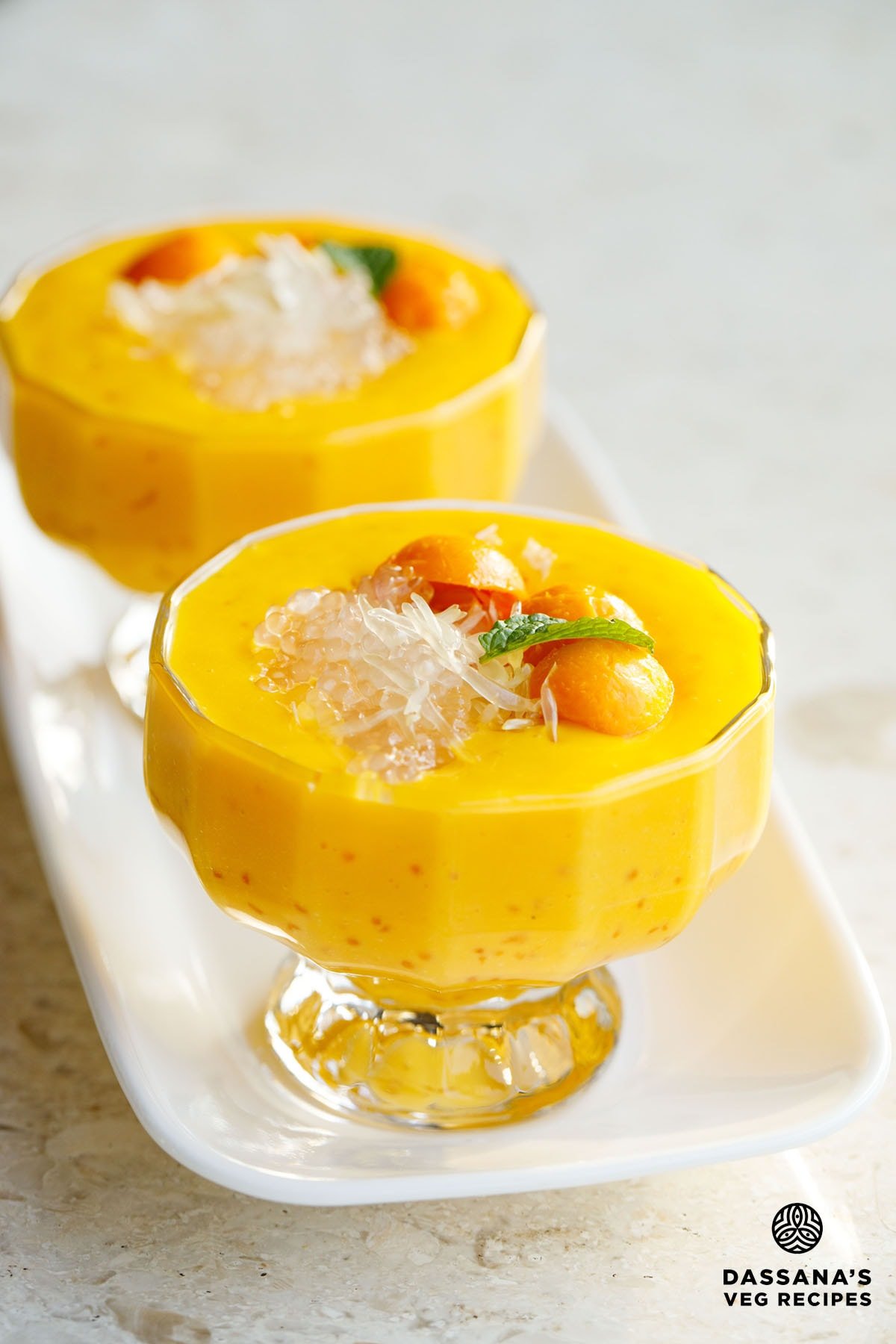

About Mango Sago
This Mango Sago recipe is a refreshing dessert that artfully balances flavor, texture, and elegance – inspired by the classic Cantonese delight, 楊枝甘露 (Yang Zhi Gan Lu), which means “Willow Branch Sweet Dew.”
Traditionally made with mango, pomelo, tapioca pearls, and coconut milk, this simpler version stays true to the spirit of the original. It’s a perfect make-ahead treat for small gatherings and best served chilled.
The dessert traces its roots back to Hong Kong in the 1980s, where it was first created by the famous Lei Garden restaurant and later became a beloved part of Cantonese cuisine.
Each spoonful of this Mango Sago brings together the tropical richness of mango, the creamy smoothness of sago (sabudana), and the juicy, citrusy crunch of pomelo.
The subtle tang and bittersweet notes from pomelo beautifully contrast the velvety mango base, creating a dessert that feels both luxurious and light.
My travels across Southeast Asia; from the bustling streets of Thailand to the quiet cafes in Laos; introduced me to this irresistible dessert.
Its vibrant flavors lingered with me, and I knew I had to recreate it at home. I’ve tried versions with and without pomelo, and while both are delicious, pomelo truly adds that extra spark – texturally and flavor-wise.
That said, if pomelo is unavailable, the dessert still shines with just mango and sago. For best results, opt for sweet, non-fibrous mangoes and small tapioca pearls, which blend seamlessly into the dessert’s creamy texture.
This recipe yields 8 servings and is easily scalable depending on your gathering size. Whether for a festive dinner or a weekend indulgence, Mango Sago never fails to impress.
Why It’s Called Mango Sago (Even Without Real Sago)
You might be surprised to know that most Mango Sago desserts today are made with tapioca pearls, not real sago. True sago, which comes from the sago palm, is quite rare and expensive these days.
What’s commonly sold as “sago” – especially in India, Southeast Asia, and even Hong Kong – is actually small white tapioca pearls made from cassava starch. Since they look similar and are much cheaper to produce, tapioca pearls have replaced real sago in everyday cooking.
That’s why even though the name has stayed, Mango Sago is now made with tapioca pearls in most places, and it’s just as delicious.
Step-by-Step Guide
How to Make Mango Sago
Cook Tapioca Pearls (Sago)
- First measure ½ cup small tapioca pearls and transfer into a mesh strainer.
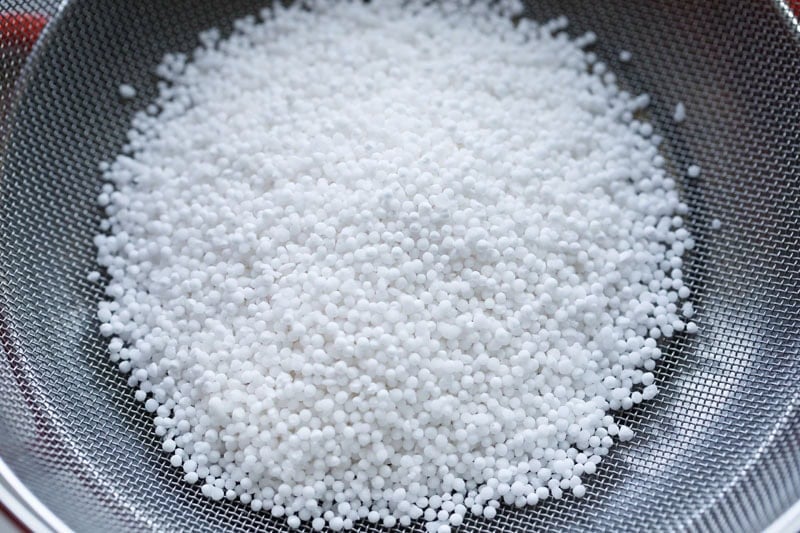

2. Rinse the tapioca pearls well under fresh water a few times.
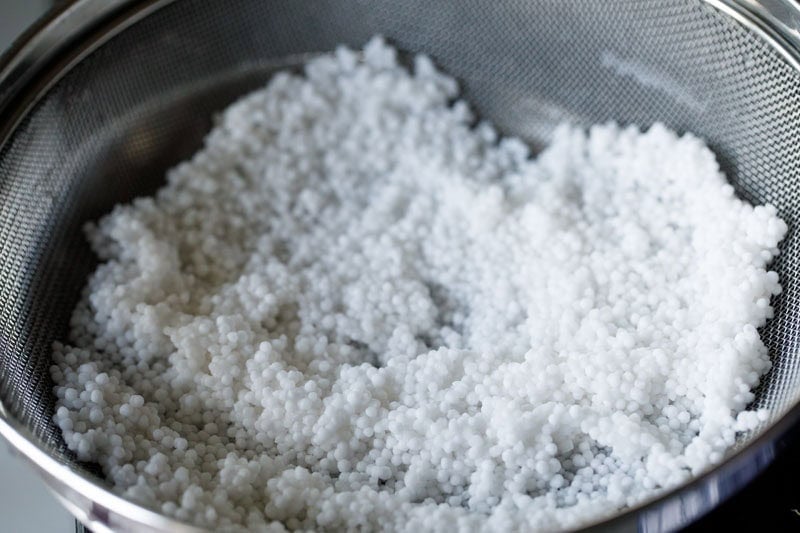

3. In a saucepan, add 5 cups water and the rinsed tapioca pearls.
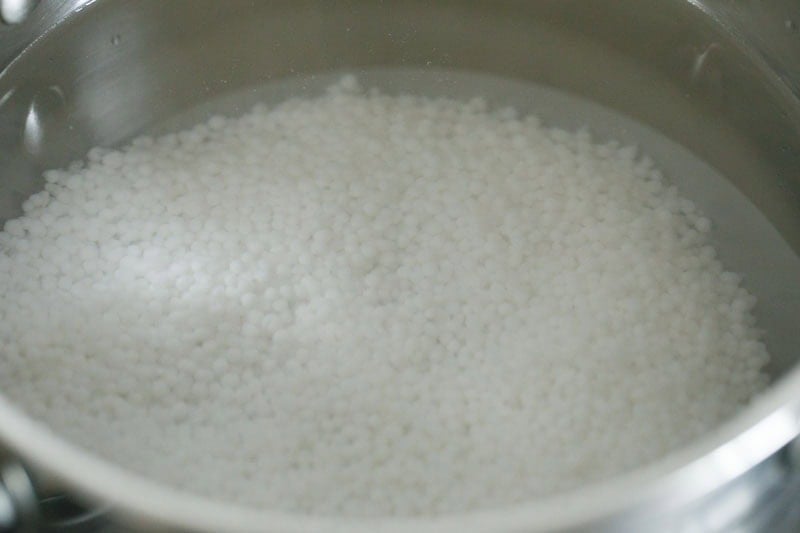

4. Cook on medium heat, stirring often, for 12 to 15 minutes or until the tapioca pearls are translucent and softened.
While cooking, the sago pearls will soften and come on top layer. This means that the have cooked and have become light.
Tip: Stir often to ensure the pearls don’t stick at the bottom of the pan.
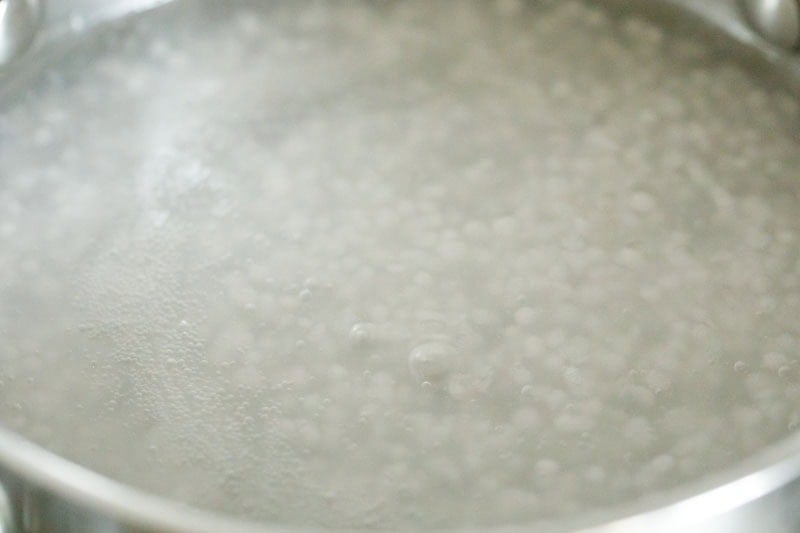

5. Turn off heat. Drain and rinse under water.
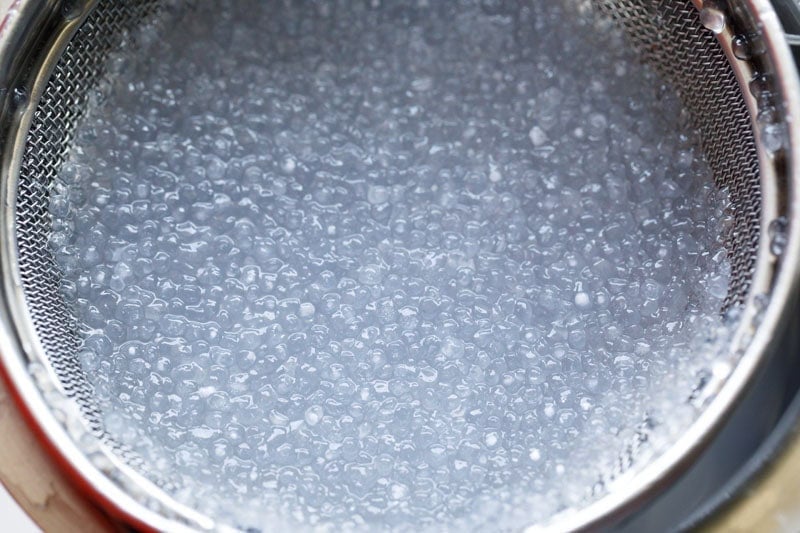

6. Soak the cooked and rinsed tapioca pearls in water for 10 minutes.
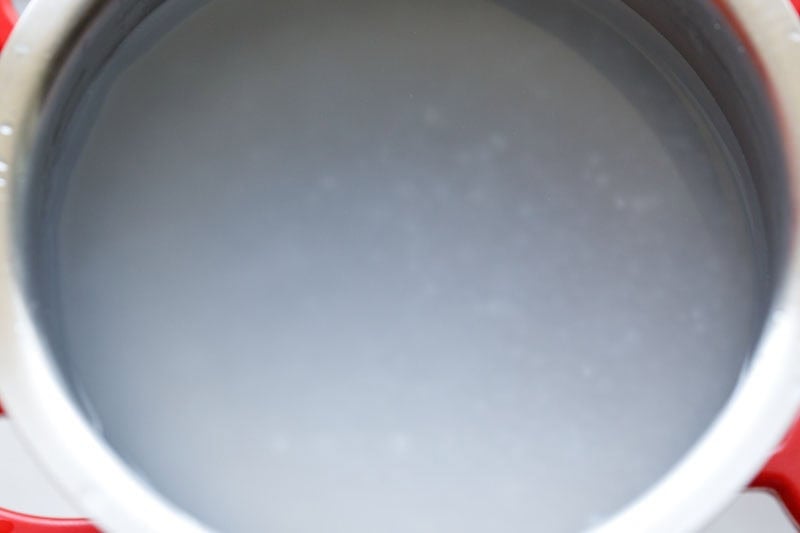

7. Drain well again and set aside.
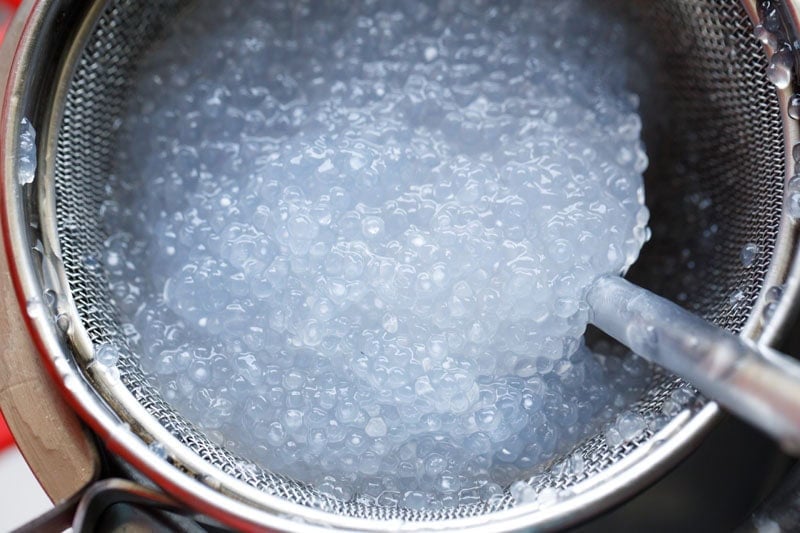

Prepare Mango Sago
8. Peel and chop 2 medium to large mangoes. I have used Alphonso mangoes here.
You must get about 2 cups chopped mangoes. In a blender, take the chopped mangoes.
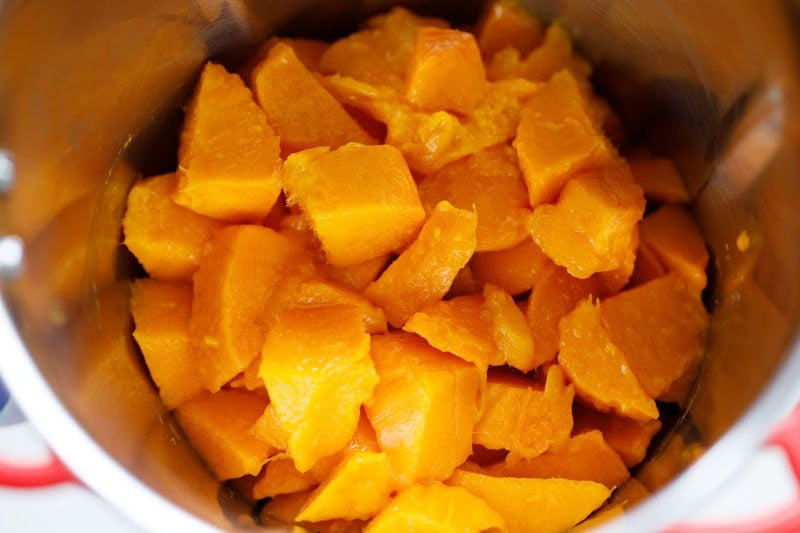

9. Blend into a fine and smooth puree.
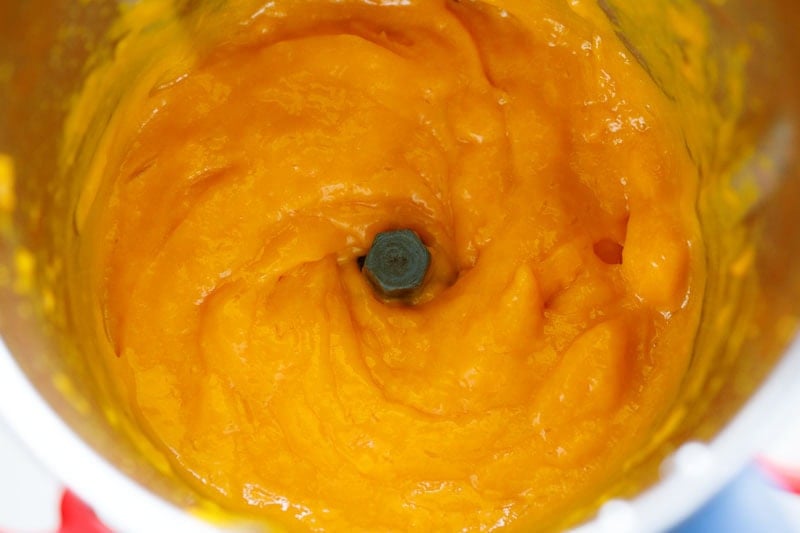

10. Add ¾ cup sweetened condensed milk and 1½ cups thick coconut milk.
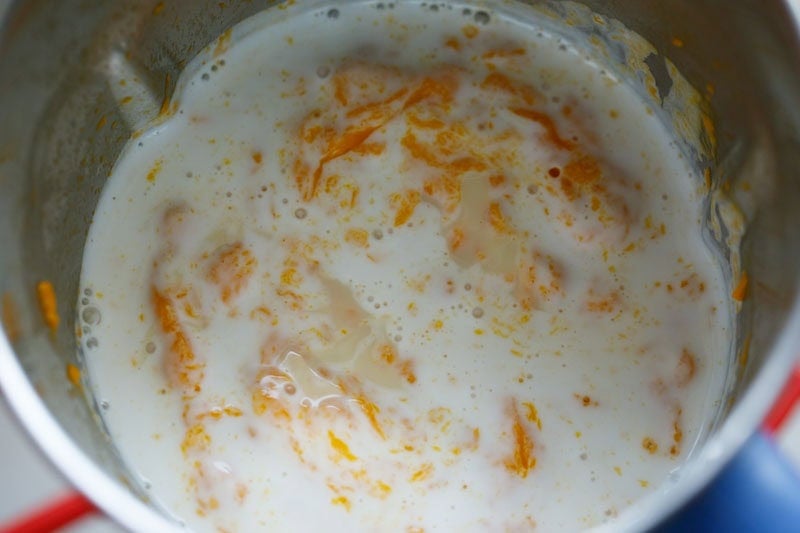

11. Blend again to a smooth consistency.
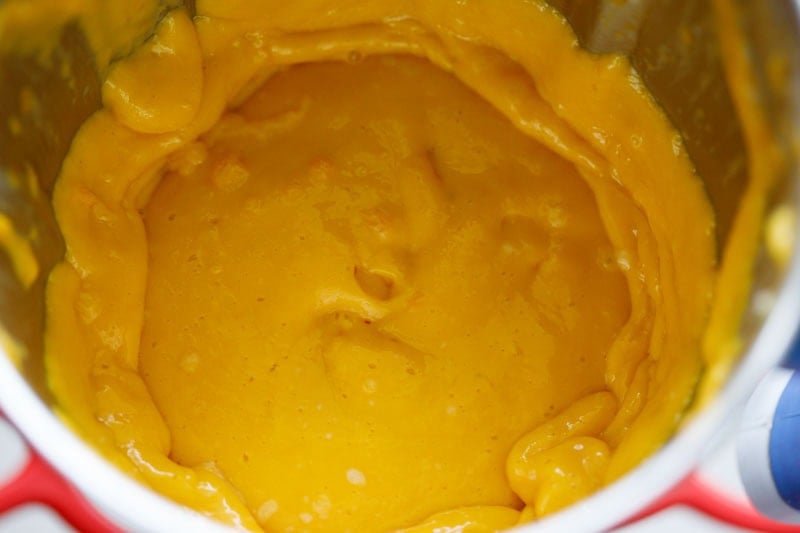

12. Pour in a large mixing bowl.
Add a pinch of salt (optional). Adding salt enhances flavor but feel free to skip it.
Add cold water if the mixture is too thick. You can opt to add cold milk instead of water. Mix well. Taste and adjust sweetness, if needed.
Cover the bowl with a lid and chill in the refrigerator.
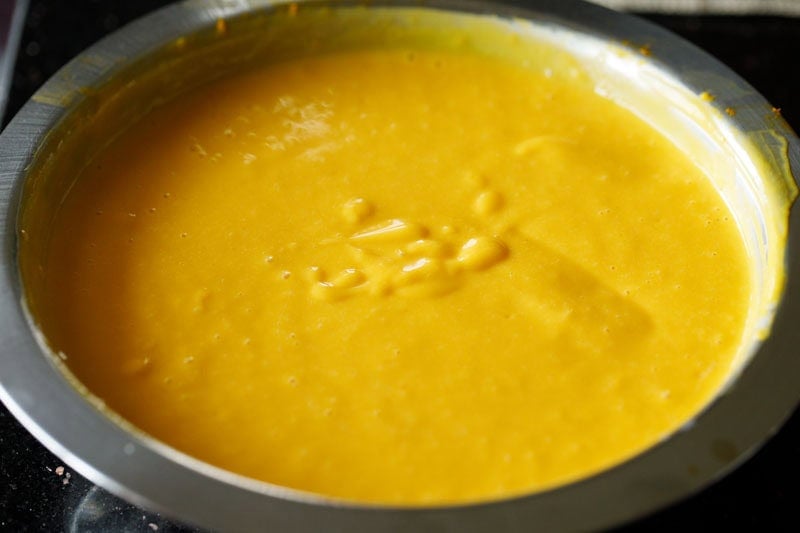

13. Peel 1 medium pomelo, separate sacs and gently break into juicy threads or small chunks.
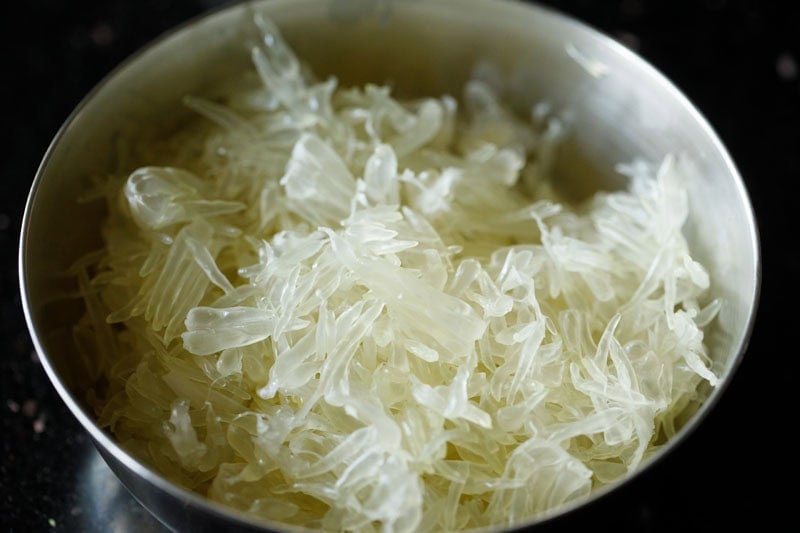

Combine & Chill
14. Fold in the cooled tapioca pearls (sago), reserving 3 to 4 tablespoons for garnish.
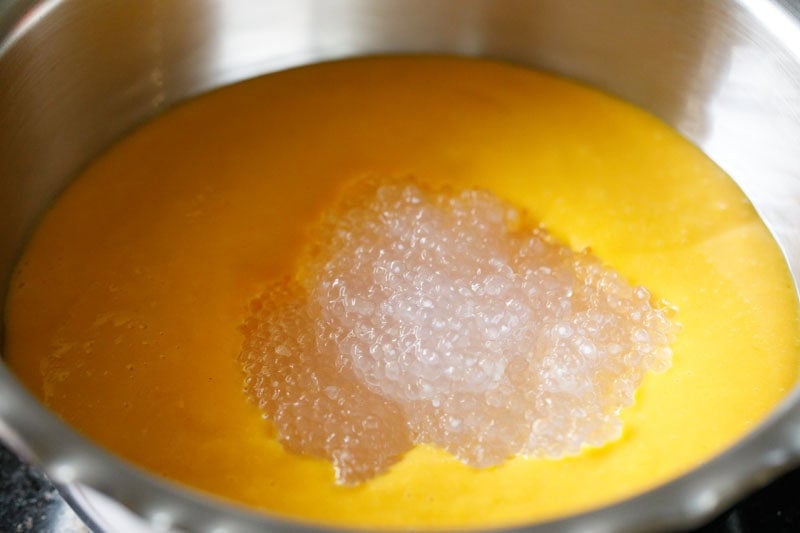

15. At this point, you can add ⅔ of the pomelo threads keeping remaining for garnish. Or choose to layer the pomelo threads in glasses while serving.
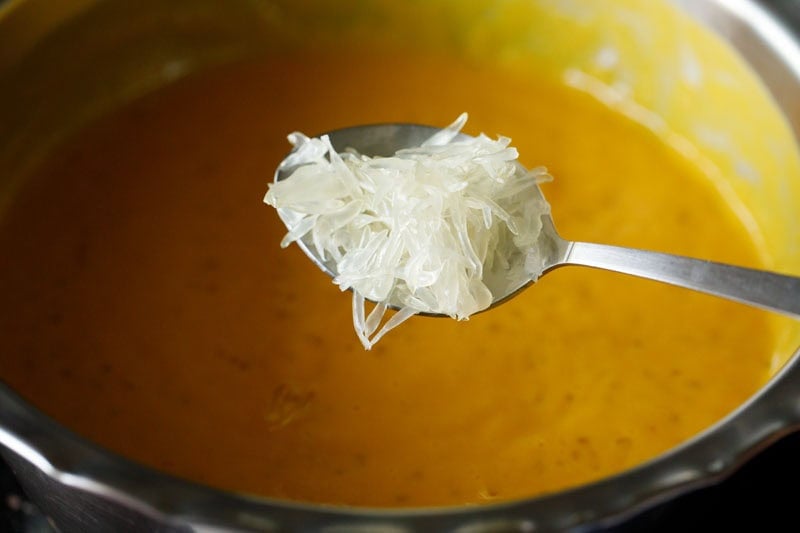

16. Chill for at least 30 minutes to 1 hour for best flavor and texture.
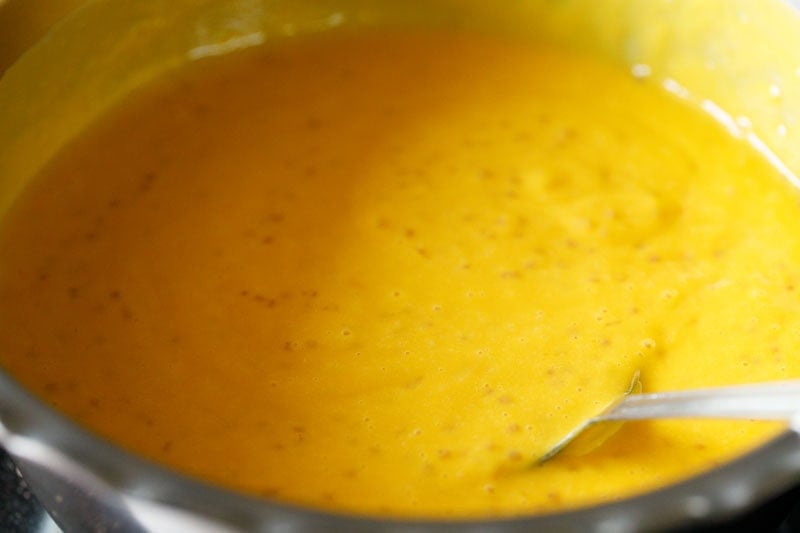

Serving Suggestions
Ladle the Mango Sago (With Pomelo) into serving bowls or glasses. Garnish with mango cubes or melon-scooped balls, along with the reserved pomelo strands and sago pearls.
For an extra touch, you can drizzle some coconut cream on top or add a sprig of fresh mint.
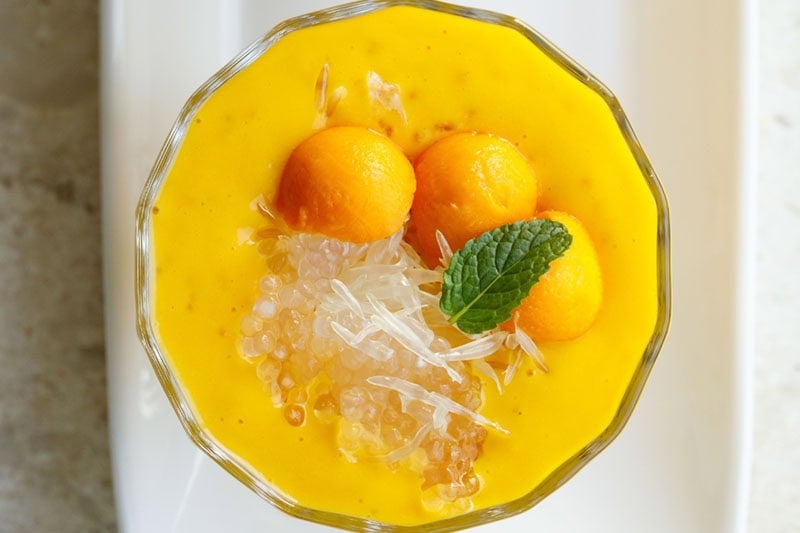

Storage Suggestions
This dessert is best enjoyed chilled. Refrigerate for at least 2 to 3 hours to let the flavors deepen, but serve it cool – not ice-cold – to maintain the creamy texture of the coconut milk.
It’s ideal to eat within 24 hours. If preparing in advance, store the mango base and toppings like pomelo and mango pieces separately, and assemble just before serving for the freshest taste and texture.
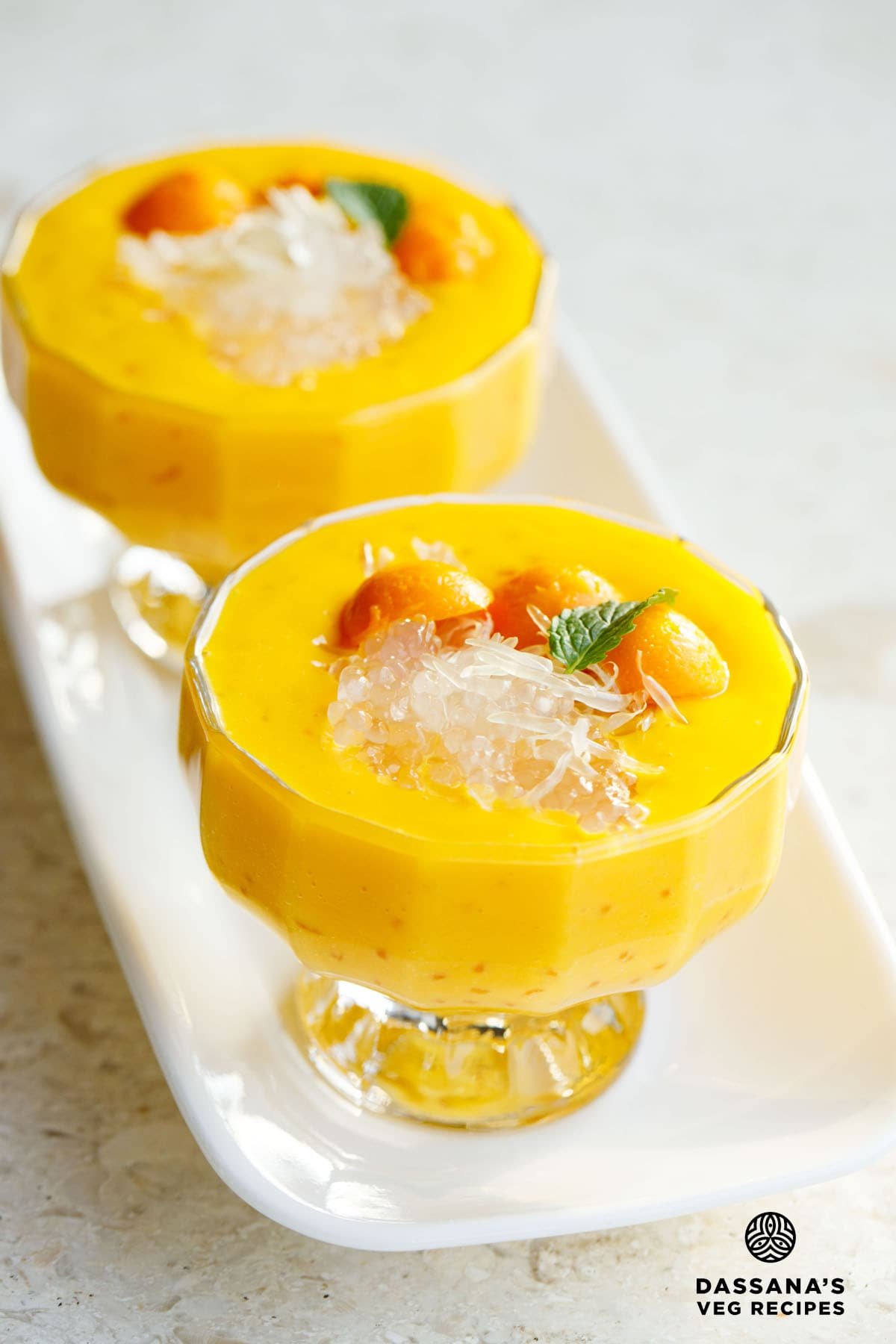

Expert Tips
- Mango varieties: For bold, aromatic flavor, Indian mangoes like Alphonso or Kesar are excellent. For a Southeast Asian twist, go with Ataulfo or Champagne mangoes for their silky texture and balanced sweetness.
- Sago prep tip: After boiling, rinse the tapioca pearls under water to stop the cooking process and prevent sticking. This keeps them pleasantly chewy and distinct.
- Sweetness control: Always taste the mango purée first – some mangoes are sweeter than others. This way, you can adjust the condensed milk accordingly to avoid overpowering the dessert with sweetness.
- Pomelo tip: Choose pomelos that are sweet with a slight tang – pink-fleshed ones not only taste great but also add a lovely pop of color. Steer clear of overly bitter varieties.
- Lighter option: For a more delicate flavor, blend 1½ cup of coconut milk with 1 cup of regular or plant-based milk of your choice; adding your preferred sweetener according to taste.
- Layered texture: Set aside some mango chunks and pomelo bits for topping rather than mixing everything in. It adds a nice contrast in texture and enhances the visual appeal.
- Vegan-friendly swap: To keep it vegan, opt for plant-based condensed milk and skip any dairy-based ingredients.
FAQs
Go for ripe, sweet mangoes with a smooth, non-fibrous texture. Any variety that yields a rich, flavorful pulp works well. Avoid stringy types, as they can interfere with the silky consistency of the dessert.
If the centers remain opaque, the pearls likely need more gentle cooking. High heat can cook the outside too quickly. Simmer slowly while stirring occasionally until most pearls turn translucent. Once done, rinse the pearls under cold water to stop the cooking process which helps them to stay separate.
Absolutely! While pomelo adds a refreshing citrusy burst, you can skip it and still enjoy a rich, fruity Mango Sago. The dessert will be delicious, though slightly less vibrant in texture and contrast.
If pomelo isn’t available, pink or ruby grapefruit makes a good substitute. It brings similar tart and juicy notes, though it may have a slightly more pronounced bitterness.
Yes, it’s easy to make vegan! Swap out regular condensed milk with a dairy-free version like sweetened condensed coconut milk or a drizzle of maple syrup. Use full-fat coconut milk to keep it creamy and indulgent while staying plant-based.
Mango Sago is traditionally named after sago pearls, which were once made from the pith of the sago palm tree. However, in most recipes today, including this one, small tapioca pearls are used instead. Tapioca pearls are made from cassava starch and are much easier to find, offering the same chewy texture that makes this dessert so enjoyable.
More Mango Recipes To Try!
Please be sure to rate the recipe in the recipe card or leave a comment below if you have made it. For more vegetarian inspirations, Sign Up for my emails or follow me on Instagram, Youtube, Facebook, Pinterest or Twitter.
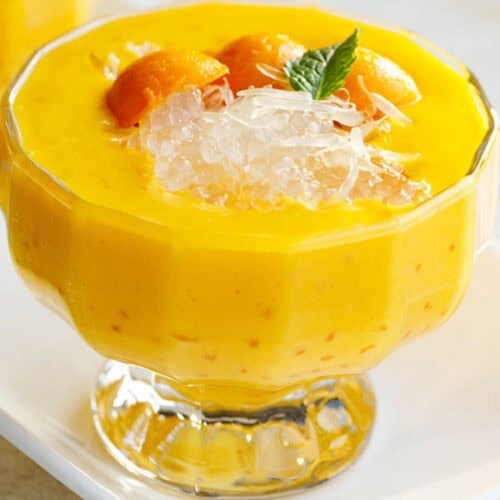

Mango Sago Recipe (With Pomelo)
Mango Sago is a light, creamy dessert made with ripe mangoes, soft tapioca pearls, coconut milk, condensed milk, and optionally juicy pomelo. Refreshing and sweet, it combines fruity flavors with a soft, chewy texture. Originating in Hong Kong, it is now popular across many parts of Asia. Chilled and served cold, it’s a perfect treat for hot summer days.
Prep Time 15 minutes
Cook Time 15 minutes
Total Time 30 minutes
Cooking Tapioca Pearls (Sago)
Prevent your screen from going dark while making the recipe
Cook Tapioca Pearls
First measure the small tapioca pearls and transfer them to a mesh strainer.
Rinse the pearls well under fresh water a few times.
In a saucepan, add 5 cups of water and the rinsed tapioca pearls.
Cook on medium heat stirring often for 12 to 15 minutes until translucent with slight white centers.
Turn off heat. Drain and rinse under cold water.
Soak in water for 10 minutes.
Drain well again and set aside.
Prepare Mango & Pomelo
Peel and chop 2 medium to large-sized mangoes. You must get about 2 cups of chopped mangoes.
In a blender, take the chopped mangoes.
Blend the mangoes into a fine and smooth puree.
Add the condensed milk and coconut milk.
Blend again to a smooth consistency.
- Pour in a large mixing bowl. Add pinch of salt, (optional).Adding salt enhances flavor but feel free to skip it.
Add cold water if the mixture is too thick. Can add cold milk instead of water. Mix well. Taste and adjust sweetness if needed.
Cover bowl with lid and chill in the fridge.
Peel pomelo, separate sacs, and gently break into juicy threads or small chunks.
Combine & Chill
Fold in the cooled sago pearls reserving 3 to 4 tablespoons for garnish.
At this point you could add ⅔ of the pomelo threads keeping remaining for garnish. Or choose to layer the pomelo threads in glasses while serving.
Chill for at least 30 minutes to 1 hour for best flavor and texture.
Serving Suggestions
Spoon into dessert bowls or glasses. Top with mango cubes or balls (scooped from melon baller scoop) and remaining pomelo threads and sago.
Optionally drizzle a bit of coconut cream or garnish with mint.
Storage Suggestions
Best served chilled. Keeps well for 24 hours refrigerated. Chilling for at least 2 to 3 hours enhances flavor.
Serve it cold, but not ice-cold, so the coconut milk remains creamy and not overly firm or frozen.
Best to consume within a day. If making a day ahead, store the base and toppings (pomelo, mango cubes) separately and combine just before serving.
- Lighter Flavor: Use 1½ cup coconut milk + 1 cup plant or regular milk + preferred sweetener according to taste
- Pomelo: Sweet-tart is best; pink preferred, yellow works too.
- Vegan: Use plant-based condensed milk.
- Mangoes: Alphonso, Kesar, Ataulfo, or Champagne work well.
- Tapioca Pearls: Cook until chewy, not mushy; rinse under cold water.
- Sweetness: Adjust based on mango and pomelo ripeness.
- Consistency: Stir in a splash of coconut milk if too thick after chilling.
- Serving: Garnish with mango cubes, pomelo, or toasted coconut.
- Make-Ahead: Chill before serving; keeps well for 24 hours refrigerated.
Nutrition Facts
Mango Sago Recipe (With Pomelo)
Amount Per Serving
Calories 247 Calories from Fat 108
% Daily Value*
Fat 12g18%
Saturated Fat 10g63%
Polyunsaturated Fat 0.2g
Monounsaturated Fat 1g
Cholesterol 10mg3%
Sodium 69mg3%
Potassium 343mg10%
Carbohydrates 34g11%
Fiber 2g8%
Sugar 23g26%
Protein 4g8%
Vitamin A 679IU14%
Vitamin B1 (Thiamine) 0.1mg7%
Vitamin B2 (Riboflavin) 0.1mg6%
Vitamin B3 (Niacin) 1mg5%
Vitamin B6 0.1mg5%
Vitamin B12 0.1µg2%
Vitamin C 35mg42%
Vitamin D 0.1µg1%
Vitamin E 1mg7%
Vitamin K 2µg2%
Calcium 103mg10%
Vitamin B9 (Folate) 32µg8%
Iron 2mg11%
Magnesium 36mg9%
Phosphorus 125mg13%
Zinc 1mg7%
* Percent Daily Values are based on a 2000 calorie diet.

Source link